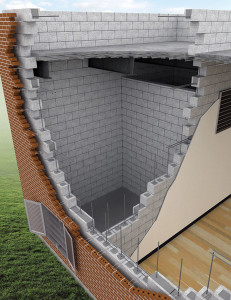Masonry Tornado Shelter Case Study: Marshall Junior High, Marshall, TX
Section 423 of the 2015 International Building Code (IBC) has a new requirement that construction for new schools and additions to existing schools (up through high school, with some limited exceptions) have tornado shelters. These shelters must comply with ICC 500-2014 ICC/NSSA Standard for the Design and Construction of Storm Shelters if the project is located in the zone where the minimum required design wind speed for a tornado shelter is 250 mph, as shown by the shaded region in the attached map. (This requirement for tornado shelters also applies to critical emergency operations such as fire, rescue and 911 call centers.)
Many of the structural engineering requirements involve coordination with a Local Emergency Planning Committee, the school district, architect, civil engineer, mechanical engineer, electrical engineer, technology designer and even the interior designer. Furthermore, ICC 500-2014 requires independent peer reviewers for both structural and architectural provisions, as well as an onsite structural engineer hired by the Owner to make observations during construction as part of the quality assurance plan. All this coordination elevates the significance of the primary structural engineer’s role during the planning of the shelter, and can require a greater effort than for traditional structures.
When Huckabee (an Architectural and Engineering firm) began master planning construction with Marshall Independent School District (MISD) in Marshall, Texas, they informed the district of the new IBC requirements. While the current building code in Marshall does not require tornado shelters yet, new construction will be required to have tornado shelters after the city of Marshall adopts the 2015 IBC. MISD elected to proactively have tornado shelters designed in all of the four new facilities associated with a recent bond program. The current building code in Marshall is the 2009 IBC, which only requires tornado shelters be designed using ICC 500-2008 if a part of a building is specifically designated as a tornado shelter. Therefore, these shelters were designed using the 2008 version (the first edition) of the ICC 500 standard.
It is important to note that there are some significant differences between the 2008 and 2014 versions of the ICC 500 standard. Both versions require standardized debris impact testing (2×4 missiles). Section 803.1 of the older version requires that doors, windows and impact-protective systems be tested at the “maximum size” listed for use. However, the new version requires these systems be tested at both the “maximum and minimum size” listed for use. The general rationale for the new, additional requirement is that smaller components can theoretically be more rigid. This rigidity means less time for energy transfer and that can equate to greater forces on parts of the system. Having specimens created and tested by a laboratory takes time and money; therefore, many component manufacturers have tested only one large size for each model and not tested small specimens yet, primarily because they have not had time to react to the new provision for minimum size testing in ICC 500-2014. The effect is that many building components need to be the same size as tested if the ICC 500-2014 standard is used, and those sizes are generally larger than is preferable for daily use of the facility. For example, ASSA/ABLOY makes a StormPro door system that would have to have 4 foot wide x 8 foot high doors rather than the smaller, standard sizes for doors.
The new Marshall Junior High is under construction currently and is designed to have 121,560 square feet of floor plan area. The Marshall ISD Local Emergency Planning Committee indicated that the number of occupants required for design of the shelter is 1,400 people, which was based on Texas Education Agency requirements and the actual anticipated population (rather than what the IBC would require for fire egress, which would be much higher); and, the City of Marshall agreed with this interpretation. ICC 500 requires at least five square feet of open floor plan area for each occupant, with ten square feet for occupants in wheelchairs. Therefore, the design team recommended using the portion of the facility generally intended for locker rooms which had sufficient open area (including a long corridor), a low roof elevation (approximately 15 feet above finish floor), and concrete masonry construction for durability and low maintenance cost in the locker room environment.
ICC 500 requires that “lay down, rollover and collapse hazards” be considered. Because the locker room area is adjacent to a series of taller practice gymnasiums, additional loads were simulated by adding the weight per square foot of wall area for the gymnasium wall system to the weight per square foot of roof area for the gymnasium roof, and multiplying that sum by 1.5 to simulate impact as with crane loads. Designers applied this additional live load pressure over a horizontal distance from the perimeter of the shelter against the gymnasium, equal in horizontal length to the difference in elevation between the top of the gymnasium parapet to the mean roof height of the shelter. This was to simulate the gymnasium wall forming a hinge at the top of the shelter and a hinge at the roof-to-wall connection for the gymnasium, with the mechanism collapsing on top of the shelter. This method was approved by the Local Emergency Planning Committee and the district’s Independent Structural Engineering Peer Reviewer.
The Tornado Shelter for the Marshall Junior High project was designed with load-bearing, reinforced concrete masonry walls with a composite steel beam and concrete slab over metal deck structural roof system. The wind pressure governed the design of the wall over the debris impact resistance criteria. The walls generally consist of fully grouted 12-inch CMU with two vertical #5 reinforcing bars (double curtain) at 16 inches on center and various patterns of horizontal reinforcement. Debris impact testing reported by Texas Tech University demonstrated that the specified masonry assembly is acceptable. Proper grouting is essential for quality masonry in tornado shelters. If voids form behind the face shells as grout shrinks, it is possible that debris impacts on the exterior face of the wall could cause the face shells on the interior face to delaminate and become projectiles within the shelter.
Instead of having a mechanical ventilation system which would require back-up power for two hours, such as an emergency generator that would need to be protected from wind pressures and debris impact, a method of providing natural ventilation was specified. Atmospheric Pressure Change (APC) venting was not provided due to the adverse impact the large openings would have on the use of the space; a value of GCp = +/-0.55 was used under the exception that does not require APC venting. Providing a means for natural ventilation when the shelter is activated, but closing off this system when the building is under normal occupancy, presents numerous architectural, mechanical, electrical, and structural challenges. There are requirements for lower openings and upper openings for air circulation. Because masonry is constructed in-place by trained craftsmen, baffling chambers, such as the one shown, that have various partitions to divert the trajectories of possible debris impact (which can be much smaller than the standardized 2×4 missile) were easy to design, specify and have constructed. (Other systems, such as precast concrete, are more limited in their ability to provide customized baffling systems that work with typical architectural floor plans.)
Tall parapets are not desirable because flying debris like trees can catch on them; therefore, a 2-foot maximum parapet height from top of the CMU to top of the concrete roof deck was designed. The 2-foot maximum parapet criteria provided sufficient height for detailing flashing and allowing roof slopes with a constant height top-of-wall architectural elevation. Because the location was not at the front of the building, the short parapet height was aesthetically acceptable. Baffling (to divert debris and thus slow down impact) is required for any openings in the shelter envelope greater than 3.5 square inches; therefore, roof drains were avoided by having the roof drain off of the low wall without a parapet.
ICC 500 requires a quality assurance plan, addressed for this project by embedding provisions in the quality control specifications for the entire project. For the entire project, the specifications require that an Independent Quality Control Agency (IQCA) perform or provide all special inspection, special testing, and structural engineering observation for the shelter according to the “Statement of Special Inspections, Testing and Observation” in Specification Section 01 4533 titled Code-Required Quality Control. The qualifications for the structural observer are that the individual be a Professional Engineer (PE) licensed in Texas and listed on the Texas Board of Professional Engineers as practicing structural engineering or be a Structural Engineer (SE) licensed in Texas. The on-site masonry inspector is required to be a certified TMS Masonry Field Testing Technician. The masonry testing technicians are required to be certified TMS Masonry Laboratory Testing Technicians.
Summary
The 2015 International Building Code has a new requirement that tornado shelters be designed in all new school construction (up through high school) in over a quarter of the United States. The MISD Junior High project is an example of how ICC 500 (which was not originally written to be a mandatory requirement for schools) was applied to provide school occupants protection from tornados. Reinforced masonry was selected for its compatibility with the use of the space, considering its durability and flexibility to meet structural and performance criteria.▪


